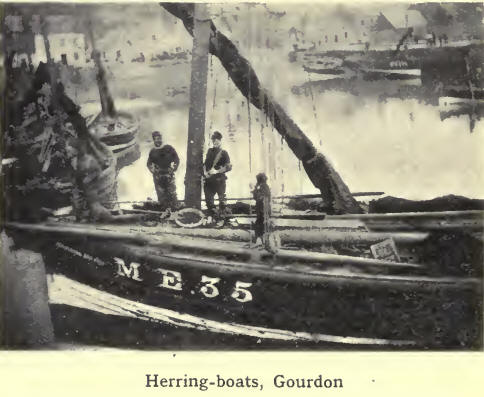Britain being an island
surrounded by shallow seas in which fish are plentiful, it is only
natural that the fishing industry should be one of the most important
sources of wealth as well as of food. Fishing is carried on vigorously
on both the west and the east coast of Scotland, but the east coast
fishing is of far greater magnitude and importance than the west coast.
The North Sea is not only an excellent fishing ground, but it also has
splendid ports where the catches can be disposed of to advantage. The
following returns of the value of the fish caught on both coasts for
1912 bring out their relative importance :
East Coast—Total value of all fish landed £2,323,580
Orkney and Shetland— „ ,, ,, 775,209
West Coast— ,, ,, ,, 352,040
Grand Total .... £3,450,829
The value of shell-fish caught on the west coast, however, exceeds
considerably that on the east coast.
The whole country is divided into districts by the Fishery Board for
Scotland each district being in charge of an officer, whose duty it is
to get and to give information on all matters connected with the
industry. The Kincardineshire small ports or “creeks,” as they are
called, are connected with the three districts of Aberdeen, Stonehaven,
and Montrose. Downies, Port-lethen, and Cove are naturally linked on to
Aberdeen ; Milton, Johnshaven, and Gourdon to Montrose. Stonehaven
includes Cowie and Skateraw to the north, and Catterline and Shieldhill
to the south.
The chief kind of fish landed on the Kincardineshire coast in 1912,
arranged in order of market value, were herrings, codlings, haddocks,
whitings, crabs, lobsters, which with less important varieties reached a
total value of £21,329, almost one-eighth of this being the value of the
shell-fish caught. The weight of all the fish landed (excluding
shell-fish) was a little over 2000 tons. Between five and six hundred
fishermen are engaged in the industry, while 235 boats or vessels of
various sizes belong to Kincardineshire. .

Since 1902, when motor
power was first introduced into the fishing industry, the progress and
increase of motor boats, slow at first, has been very marked. In this
innovation, the pioneers in the county were the fishermen of Gourdon and
Johnshaven.
More than a century ago salmon fishing gave employment to 135 hands, and
the rental of the fishings amounted to £2700 a year. At present the
assessable rental of the three districts—Bervie, North Esk, and Dee—is
£27,825, about one-sixth of the rentals of the forty Scottish districts
having boards to regulate and protect salmon fishing. The number of
salmon caught annually either in the sea by a “fixed engine”—the stake
and bag nets—or by rod in the waters of the rivers of the county, cannot
be determined ; but the weight of salmon carried by the railways in 1912
was 1990 tons, almost half of this quantity being caught in the area
from Berwick to Cairnbulg Point in the northeast of Aberdeenshire. Of
this a considerable proportion must have been contributed by the
Kincardineshire salmon fishings.
|

